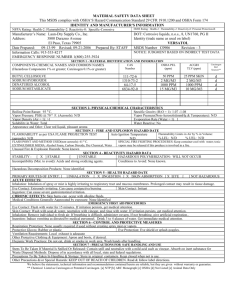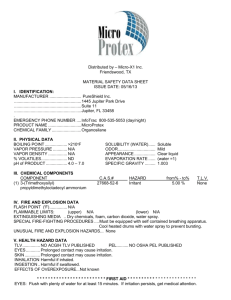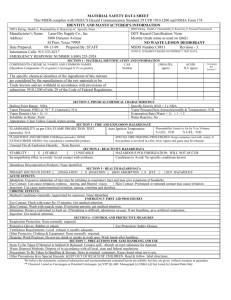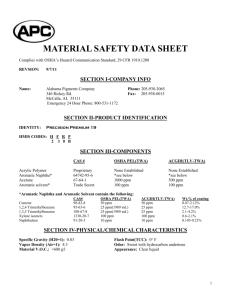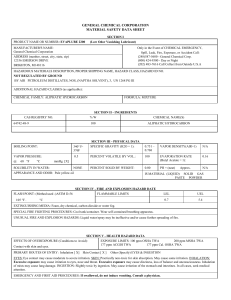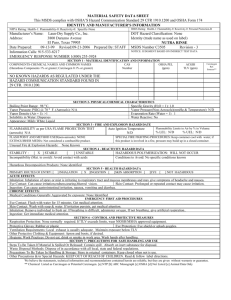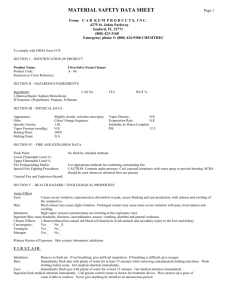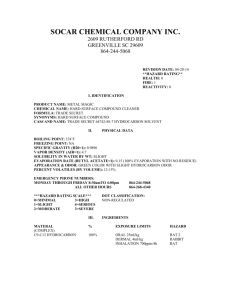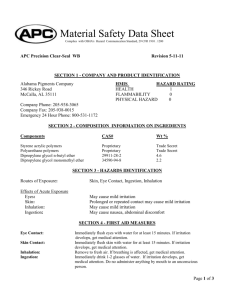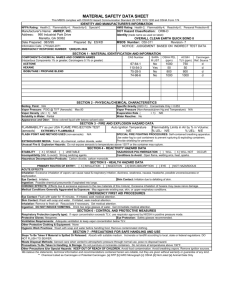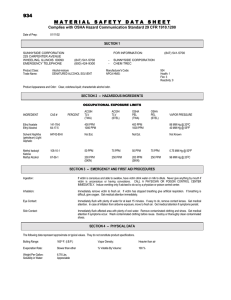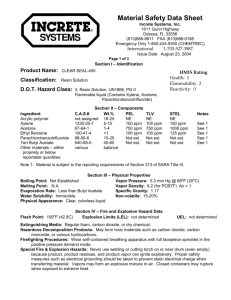material safety data sheet
advertisement
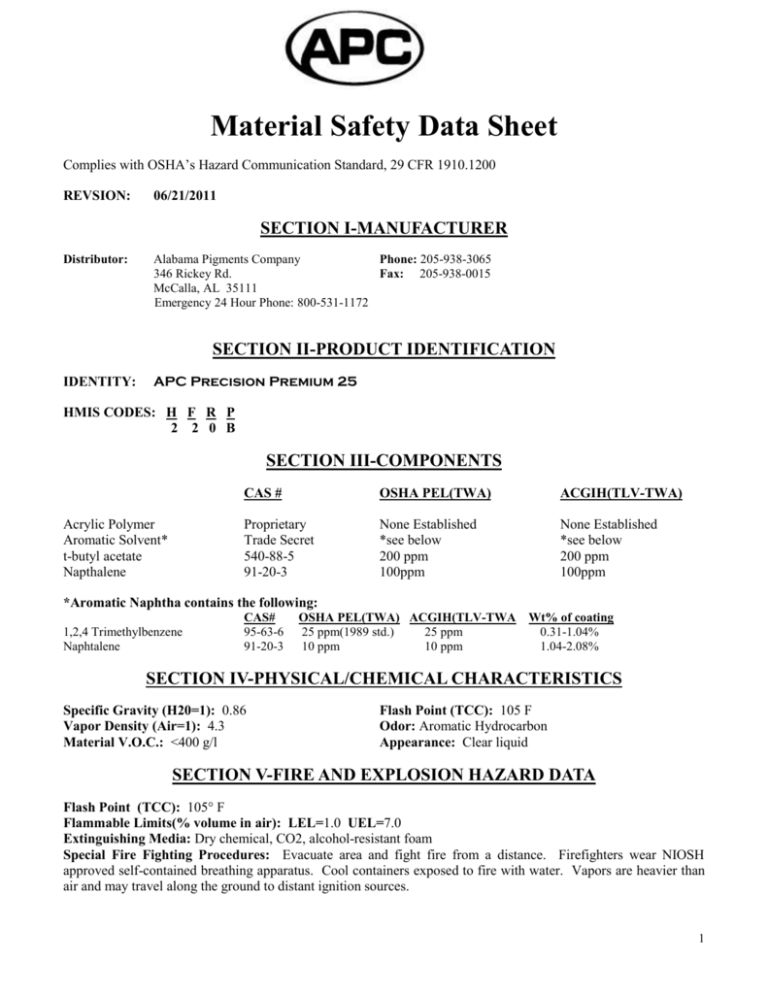
Material Safety Data Sheet Complies with OSHA’s Hazard Communication Standard, 29 CFR 1910.1200 REVSION: 06/21/2011 SECTION I-MANUFACTURER Distributor: Alabama Pigments Company Phone: 205-938-3065 346 Rickey Rd. Fax: 205-938-0015 McCalla, AL 35111 Emergency 24 Hour Phone: 800-531-1172 SECTION II-PRODUCT IDENTIFICATION IDENTITY: APC Precision Premium 25 HMIS CODES: H F R P 2 2 0 B SECTION III-COMPONENTS Acrylic Polymer Aromatic Solvent* t-butyl acetate Napthalene CAS # OSHA PEL(TWA) ACGIH(TLV-TWA) Proprietary Trade Secret 540-88-5 91-20-3 None Established *see below 200 ppm 100ppm None Established *see below 200 ppm 100ppm *Aromatic Naphtha contains the following: 1,2,4 Trimethylbenzene Naphtalene CAS# 95-63-6 91-20-3 OSHA PEL(TWA) ACGIH(TLV-TWA 25 ppm(1989 std.) 25 ppm 10 ppm 10 ppm Wt% of coating 0.31-1.04% 1.04-2.08% SECTION IV-PHYSICAL/CHEMICAL CHARACTERISTICS Specific Gravity (H20=1): 0.86 Vapor Density (Air=1): 4.3 Material V.O.C.: <400 g/l Flash Point (TCC): 105 F Odor: Aromatic Hydrocarbon Appearance: Clear liquid SECTION V-FIRE AND EXPLOSION HAZARD DATA Flash Point (TCC): 105° F Flammable Limits(% volume in air): LEL=1.0 UEL=7.0 Extinguishing Media: Dry chemical, CO2, alcohol-resistant foam Special Fire Fighting Procedures: Evacuate area and fight fire from a distance. Firefighters wear NIOSH approved self-contained breathing apparatus. Cool containers exposed to fire with water. Vapors are heavier than air and may travel along the ground to distant ignition sources. 1 SECTION VI-REACTIVITY DATA Reactivity: Stable Conditions to avoid: Prevent vapor accumulation. Avoid heat and flames. Incompatibility (Materials to Avoid): Strong oxidizers. Hazardous Decomposition (Byproducts): Carbon monoxide and carbon dioxide. Hazardous Polymerization: Should not occur. SECTION VII-HAZARDS IDENTIFICATION Routes of Exposure: Inhalation, Ingestion, eyes, and Skin. Health Hazards: Acute: May cause eye, skin, gastrointestinal, and lung irritation. May cause central nervous system depression. Chronic: Prolonged and repeated exposures to high concentrations may cause hearing loss. May cause anemia, decreased blood cell count, and bone marrow hypoplasia. Liver and kidney damage may occur. Exposure to toluene may affect the developing fetus. Skin Contact: May cause irritation and redness. Prolonged or repeated exposure can cause defatting and drying of the skin, which may result in a burning sensation and a dried, cracked appearance. Eye Contact: May cause redness, tearing, and irritation of the eyes. Direct contact may cause permanent eye damage. Inhalation: May cause headache, nausea, dizziness, and loss of coordination. Continued inhalation may result in unconsciousness and death. Ingestion: May be harmful if swallowed. Aspiration of the material into the lungs can cause chemical pneumonitis, which can be fatal. Carcinogen: Contains trace amounts of Naphthalene (0.625-1.25% by wt.), which has been shown by the NTP to be carcinogenic. Aggravation of Pre-existing Conditions: Persons with pre-existing skin, eye, or lung disorders may be more susceptible to the effects of the substance. SECTION VIII-SARA Sections 311-313 INFORMATION SARA 311/312: SARA 313: Acute Health Hazard Fire Hazard Chronic Health Hazard Components See Section III (Aromatic Naphtha and Mineral Spirits components) SECTION IX-EMERGENCY AND FIRST AID PROCEDURES Skin: Clean material from skin with acetone, then wash with soap and water followed by moisturizer. Eyes: Flush with a gentle but large stream of clean water for 15 minutes, lifting the lower and upper eyelids occasionally. Call a physician if irritation persists. Inhalation: Move to fresh air and provide oxygen if breathing is difficult. Seek medical attention. Ingestion: DO NOT INDUCE VOMITING. Give large quantities of water. If vomiting occurs spontaneously, keep head below hips to prevent aspiration of liquid into the lungs. Get medical attention immediately. 2 SECTION X-PRECAUTIONS FOR SAFE HANDLING AND USE Normal Handling: Always use good industrial hygiene practices and safety guidelines. Storage: Store material in its original container. Keep containers tightly closed when not in use. Keep material away from open flame, sparks, or other sources of heat and ignition. Waste Disposal Method: Liquid material is an ignitable waste (D001). Dispose of material in accordance with federal, state, and local guidelines. Special Precautions: Use proper bonding/grounding techniques to avoid static buildup/discharge, which can ignite vapors. Empty containers may contain explosive levels of vapor. Do not cut, drill, or weld on or near the containers. SECTION XI-EXPOSURE CONTROLS/PERSONAL PROTECTION Respiratory Protection: Use a NIOSH-approved organic vapor respirator when exposure level cannot be maintained below limits. Ventilation: Provide adequate mechanical ventilation to keep exposure levels below TLV’s. Protective Gloves: Wear impervious chemical gloves. Eye Protection: Wear chemical safety glasses. Other Protective Clothing or Equipment: As needed to prevent repeated/prolonged contact. Work/Hygienic Practices: Use only in adequately-ventilated area unless recommended respiratory protection is used. Wash thoroughly with soap and water after handling and before eating, smoking, or using washroom. If clothes become contaminated, change to clean clothing and wash contaminated clothes before re-use. SECTION XII-TRANSPORTATION INFORMATION Proper Shipping Name: Paint Hazard Class: 3 UN: UN1263 Packing Group: PGII SECTION XIII-ADDITIONAL REGULATORY INFORMATION The regulatory information provided is not intended to be comprehensive. Other federal, state and local regulations may apply to this material. OSHA: This material is hazardous by definition of Hazardous Communications Standard (29 CFR 1910.1200). TSCA: Components of this material are either listed or are exempt from the EPA TSCA Inventory of Chemical Substances. California Proposition 65: Naphthalene (91-20-3) 0.184-0.368% CA_65 C WARRANTY DISCLAIMER The facts stated and recommended regarding APC products are based on our own research and the research of others, and are believed to be accurate. APC products are sold without WARRANTY, expressed or implied, and on the condition that the purchasers conduct their own tests in order to determine the suitability of such for their particular purpose. The user is solely responsible for the use and information regarding APC products. APC disclaims any liability. APC disclaims any warranty of merchantability or fitness of this product for any particular purpose. 3
